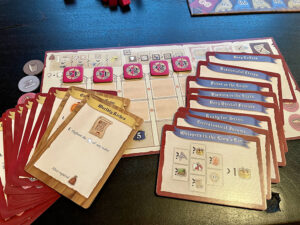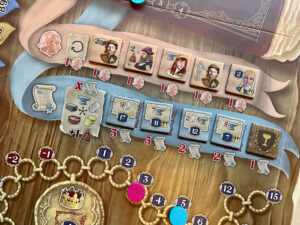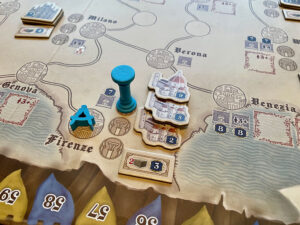 The “T” series of games that live on through the efforts of production house Board & Dice feature a centralized game mechanism that powers everything else. In Teotihuacan, it was rondel movement and aging workers. In Tekhenu we saw how the sun could cast shadows and change the purity of dice. And in Tabannusi dice dictated future actions and resource collection.
The “T” series of games that live on through the efforts of production house Board & Dice feature a centralized game mechanism that powers everything else. In Teotihuacan, it was rondel movement and aging workers. In Tekhenu we saw how the sun could cast shadows and change the purity of dice. And in Tabannusi dice dictated future actions and resource collection.
Tiletum brings with it the pedigree of designer duo Daniele Tascini and Simone Luciani (of Voyages of Marco Polo and Tzolk’in fame) and another twist on dice selection. It also dabbles in an overdone setting and features a lot of beige. Is there enough innovation here to convince gamers to seek riches as merchants in Renaissance Europe? Or will the entire exercise feel like a retread on old ideas?
Gameplay Overview:
As wealthy merchants, players select three dice per round which activate an action and gain them resources. There are five colors of dice, and each is related to a specific resource: gold, food, wool, stone, and iron. The number of pips on a selected die earns a player that many resources based on the die color. And where the die resided around the action wheel on the main board determines the type of action to be taken.
Players place an architect and a merchant at Tiletum during setup. This is the starting point on the main board’s map of Europe that is seeded with different bonus tokens, cathedral tiles, and fair destinations. The main board also features the action wheel, a contract and character market, as well as a King’s track to monitor corruption.
Why do we want specific dice? Each is situated on one of six action spaces based on their pip value. The amount of action points is based on the opposite pip value. For example, a die that provides six gold only provides one action. A dice that only provides one wool also provides six actions.

Let’s look at the six actions available:
• Architect: 1 action point (AP) to move, add a pillar to a town, or take a bonus tile.
• Merchant: 1 AP to move, add a house to a town, or take a bonus tile.
• Character: 1 AP to take a character tile or refresh the market. 1/2/3 AP to move a character into a room on your personal player board.
• Contract: 1 AP to exchange resources and 1-3 AP related to where contract tiles are in the market.
• King: Advance your token on the King’s track the number of spaces equal to your AP.
• Joker: Wild card action that allows players to choose any other single action and use the available AP there.
Choosing a die provides both economy and action. As such, players are constantly assessing their available options. There are multiple routes to points, whether it be completing contracts with wool and iron, adding pillars and using stone to construct cathedrals, adding houses to compete in end-of-round fair scoring, or focusing on the King’s track to gain points and take first player next round.

Everything is interconnected. Completing a contract unlocks more pillars for cathedral construction. Characters added to your player board rooms provide one-time bonuses and unlock more houses you can add to the map. Bonus tiles acquired by being the first to take a die on an action space, or by taking the limited supply on the map (these do not refresh), provide bonus actions, resources, or even boosts to your next action.
The end of each round brings a fair scoring based on random towns and scoring criteria selected before the start of the game. The first fair is always Tiletum and each player has a house placed here during setup. The other three fairs require players to either have a house or their merchant in the town listed. And with only a certain amount of space for houses, this avenue for scoring provides direction for additional points that perhaps not everyone can gain.
Players earn points for completed contracts, end-of-round scoring, bonus and character tiles, and even the King’s track (players can lose points here too). At the end of the game, players gain points by multiplying their houses by their pillars on the map, counting their completed rooms on their personal player boards, as well as receiving one point for every four leftover resources.

Game Experience:
The dice selection mechanism employed here may be my favorite of the “T” series so far. And in fact, everything in Tiletum is a tight balancing act that powers a wide range of options. Do you focus on the merchant action to get more houses onto the map, but miss out on pillars and the end-game multiplier? Do you focus on completing contracts to get more pillars and thus more cathedral constructions? Do you focus on the King’s track? And which dice values and their corresponding actions will allow for any of this?
Much of this is compounded by the design choice to add two different “workers” onto the map that power the end-game multiplier. While you can find combos with bonus tiles to utilize both during a single turn, the choice of which to activate comes down to die options. Thankfully Tiletum has mitigation via gold to adjust die values up or down. And with more players at the table, options get very tight and create a best-of-what’s-available decision space.

And it’s quite excellent. Most of the actions feel meaningful and the design is constantly challenging players to try something different. If you go the same route as another player, you may not get the bonus tiles to increase your efficiency. Want to follow the previous player by taking merchant action they just took because there is only one die left in that space? Well, there won’t be a bonus tile for you because it’s already been snatched up and those don’t refresh until the next round.
Additional pressure is applied by the King’s track. This track functions similarly to the Emperor track in Luciani’s Grand Austria Hotel, but whereas the Emperor track is multi-faceted and provides both bonus and penalty after a certain number of rounds, here the King’s track corruption tiles are drawn after all players have taken their first/second/third dice. Corruption tiles penalize players who do not move up the track, but beyond a loss of points, they don’t do much else. And in a game with scores well over 100 points, the King’s action feels lackluster compared to the others. It could’ve used more consideration.

The personal player boards also provide limitations. First, there are four inventory spaces that cannot be overfilled or replaced. Want that available bonus tile? Well, you can’t until you complete at least one of the four contracts you’re hoarding. The player boards also feature rooms in five “houses” that can be filled by characters. The limitation? You can only have a specific type of character in each house column, thus dictating which characters you need to seek out.
The final resource I’ve not discussed is food. Food supplies a tile type called a crest. Each room on the personal player board has room for a unique crest. There can never be two of the same on your board. Each crest provides a powerful bonus action and combines with a house full of characters to unlock a token that provides extra value to your dice actions based on which character type is in the house. Ultimately these become targets for players looking to boost their actions and scoring.

Tiletum plays well at all player counts and even has a solo mode that is a bit convoluted but becomes clearer the more you play it. The player scaling here is excellent—fewer dice, fewer tiles, and less space for pillars and houses. What’s not excellent? The game’s look and a few production oversights. This game screams dry Euro due to its setting and the number of tired illustrations on display. If any additional support would’ve been given to boosting the illustration it would’ve gone a long way toward making this a classic. Also, the need for so many resource chits and cathedral tiles could’ve been made obsolete with resource trackers and printed cathedral point values.
Final Thoughts:
Despite trying its best to push me away from the visuals alone, I’ve overcome my hesitations after sitting down to the excellent gameplay here. Tiletum showcases both designers’ best from past titles and meshes it all together in a refresh that feels just as vital. Could this be the best work from them? I’m not prepared to say that, but the dice selection and the constant limitations are so satisfying. The variability and paths to points are diverse and exciting. I imagine that with a different theme and some attention to aspects mentioned in the review, this could’ve been a modern classic. That said, this still stands tall on the shelf next to its “T” series brethren. It may even be one of the best in that popular collection.
Final Score: 4 stars – Even with a tired theme and uninspired illustration, Tiletum’s mechanisms elevate it to prominent status within the “T” series.
 Hits:
Hits:
• Dice selection
• Player scaling
• Dual route traveling
• Limited inventory
Misses:
• Game looks so tired
• King’s track not punishing enough
• Resources/cathedral tiles fiddly





















